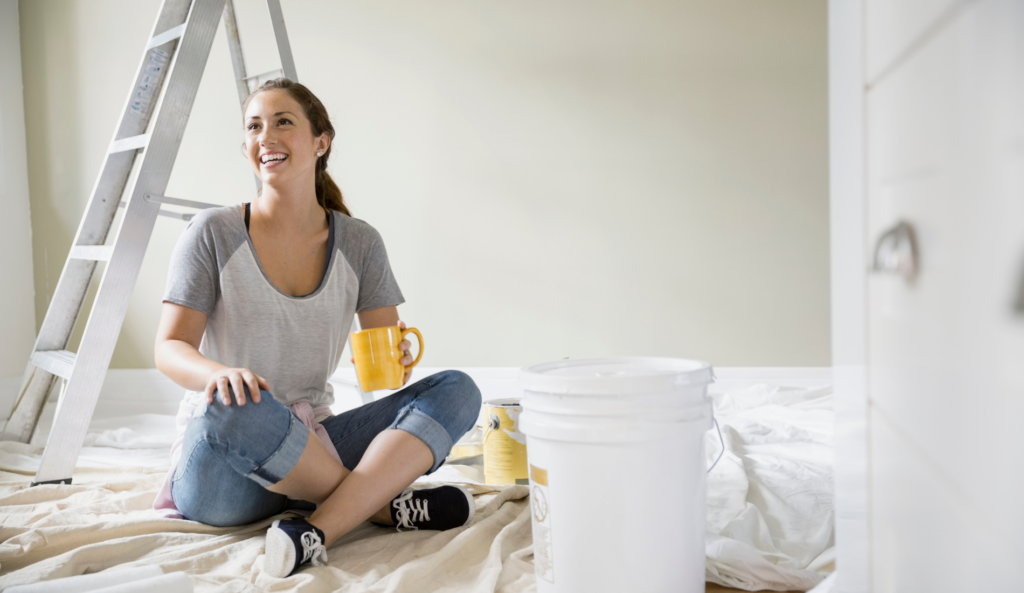Proper preparation is crucial when it comes to achieving professional-quality painting results. Many DIY painters tend to overlook or rush through the prep work, eager to get to the fun part of actually painting. However, skipping or skimping on prep work can result in a subpar finish that will not only be noticeable but also lead to more time and money spent on fixing mistakes
Tools Needed for Paint Preparation
- Drop cloths or plastic sheeting: These are used to protect floors and furniture from paint spills, drips, and splatters. It is important to cover all surfaces that may be exposed to paint to avoid any damage.
- Painter’s tape: This type of tape is specifically designed for painting projects and can easily be removed without damaging the surface underneath. It is used to mask off areas that should not be painted, such as trim, windows, and door frames.
- Sandpaper or sanding block: These tools are used to smooth out any rough surfaces on walls, ceilings, or woodwork. It is important to use the correct grit of sandpaper for each surface and to sand in a consistent direction.
- Tack cloth or damp rag: After sanding, it is important to remove all dust and debris from the surface before painting. A tack cloth or damp rag can be used to wipe down the surface and ensure a clean surface for painting.
- Putty knife: This tool is used to fill in any holes, dents, or cracks in walls or woodwork. It is important to use the appropriate type of filler for each surface and to smooth out any excess with the putty knife. Once the filler is dry, it can be sanded down for a smooth finish.
Importance of Proper Prep Work
The time and effort put into proper prep work will pay off in the end result of your painting project. Some key reasons why proper prep work is crucial include:
- Better adhesion: Properly prepped surfaces allow for better adhesion of paint, ensuring that it will stick and last longer without chipping or peeling.
- Smoother finish: Sanding down rough areas and filling in any imperfections will result in a smoother finish once the paint is applied.
- Cleaner lines: Using painter’s tape and taking the time to mask off areas will result in cleaner lines and a more professional-looking end product.
- Time and cost savings: Proper prep work can save time and money in the long run by avoiding mistakes or having to redo a project. It also allows for a more efficient painting process, as the painter can focus on applying paint rather than fixing errors.
Step-by-Step Guide to Proper Paint Preparation
Cleaning the Surface
The first step in proper paint preparation is to ensure that the surface is clean and free of any dirt, dust, or grease. A mild soap and water solution can be used for this, along with a sponge or rag. Any stains or residue should be cleaned off before moving on to the next step.
Repairing Imperfections
Once the surface is clean and dry, it is time to assess and repair any imperfections. This may include filling in holes, cracks, or dents with a suitable filler and allowing it to dry before sanding.
Sanding
Sanding should be done after any repairs have been made and the filler is completely dry. The goal of sanding is to smooth out any rough areas and create a surface that is ready for painting. It is important to use the appropriate grit of sandpaper for each surface and to sand in a consistent direction.
Masking Off Areas
Using painter’s tape, mask off any areas that should not be painted, such as trim, windows, and door frames. Take the time to ensure that the tape is applied evenly and securely to avoid any paint bleed-through.
Protecting Surfaces
Before beginning to paint, it is important to protect any surfaces that may be exposed to paint. This includes using drop cloths or plastic sheeting to cover floors and furniture. It is also a good idea to cover doorknobs, light fixtures, and other hardware with plastic bags or tape.
Apply Primer (If Needed)
Depending on the surface and type of paint being used, a primer may be needed before painting. This will help to ensure better adhesion and coverage of the final paint coats.
Final Inspection
Before starting to paint, it is important to do a final inspection of the prepped surfaces to ensure that everything is clean, smooth, and properly masked off. Making any necessary adjustments at this stage will save time and effort in the long run.
Conclusion
Proper prep work is essential for achieving professional-quality painting results. Taking the time to properly clean, repair, sand, mask off, and protect surfaces will ultimately lead to a smoother finish and cleaner lines. By following these steps and using the right tools, you can ensure that your painting project turns out beautifully and lasts for years to come. So, always remember the importance of proper prep work before starting any painting project. Happy painting!
Additional Tips for Successful Painting
- Use a high-quality paintbrush or roller: Investing in good-quality tools will make a big difference in the outcome of your painting project. High-quality brushes and rollers will apply paint more evenly and smoothly, resulting in a better finish.
- Follow the manufacturer’s instructions: Different paints may have different application instructions, such as drying time and recommended number of coats. It is important to follow these instructions for best results.
- Use proper ventilation: When painting indoors, it is important to have good ventilation to avoid inhaling fumes or becoming lightheaded. Open windows or use fans to circulate air during the painting process.
- Take breaks: Painting can be a physically demanding task, so it is important to take breaks and stretch regularly to avoid strain or fatigue.
- Clean up properly: After completing your painting project, make sure to clean up any tools, paint cans, and drop cloths properly. Use soap and water for latex paints, and mineral spirits for oil-based paints.
- Allow the paint to dry completely: Before moving any furniture or removing tape from walls, make sure to allow the paint to dry completely. This will prevent smudging or ruining your hard work. By following these additional tips, you can ensure a successful painting project that will leave you with a beautiful, professional-looking finish. Good luck with your painting endeavors! Happy painting!
References
- Bob Vila (2021). “13 Top Tips to Make Any Paint Job Go Faster“.
- The Family Handyman (2023). “Indoor Painting Tips & Techniques“.
- Benjamin Moore – “How To Prepare Walls For Painting“


